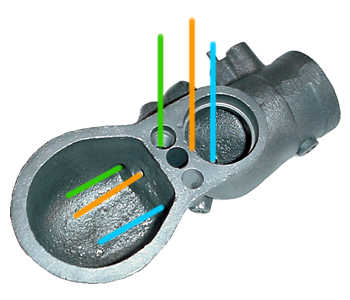Model-A.org
The Place for Model-A Ford Carburetors
Model-A.org
The Place for Model-A Ford Carburetors
Lower Casting Passages

- Casting Passages for the flow of gasoline and air are critical "Components" of the carburetor that are often overlooked. Sections of some passages had to be drilled via the outside surface of the casting. Then the ends were filled with brass plugs. When rebuilding carburetors, I recommend that the plugs be drilled out, passage cleaned out, and then replugged. These Brass plugs are available at most Model A parts suppliers.
- The Blue line identifies the Passage that provides gasoline to the Main Jet from Float Bowl. It is connected via the Drain Plug opening. If this passage is restricted too much, it can cause a lean mixture at high speeds.
- The Orange line identifies the Passage that provides gasoline to the Cap Jet from the Float Bowl. It is connected via the Compensator Jet opening, and through the Secondary Well. On some castings, the passage was drilled straight through to the bottom of the cap jet. On other castings, the passage may make a jog when going from the secondary well to the bottom of the cap jet. If the passage is restricted too much, it can cause a lean mixture at low speeds.
- The Green line identifies the Gas Adjusting Valve Passages which provide additional gasoline to the Cap Jet. On most castings, the passage from the top of the GAV seat goes to the secondary well, and then to the bottom of the cap jet. However, on others, the passage goes from the top of the GAV seat directly to the bottom of the cap jet. If these passages are restricted, Opening the GAS Adjusting Valve does NOT provide any extra fuel at low speeds. This passage from the Float Bowl is the lowest and most likely to collect sediment. It's the passage that I find most likely be totally blocked.
- It was found that the Float Bowl needs to be vented to atmosphere to prevent conditions that could affect Float Valve operation. On Lower Castings (After mid 1930) there is an air vent.
